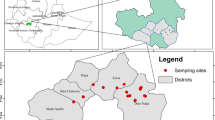Abstract
National data from the hydrological network for 38 rivers out of 25 watersheds were used to detect spatial and temporal trends in water quality and quantity characteristics between 1995 and 2002. Assessment of water quality and quantity included flow rate, water temperature, pH, electrical conductivity, sodium adsorption rate, Na, K, Ca+Mg, CO3, HCO3, Cl, SO4, and boron. Among the major ions assessed on a watershed basis, Turkish river waters are relatively high in Ca+Mg, Na and HCO3, and low in K and CO3. The watersheds in Turkey experienced a general trend of 16% decrease in flow rates between 1995 and 2002 at a mean annual rate of about 4 m3 s−1, with a considerable spatial variation. Similarly, there appeared to be an increasing trend in river water temperature, at a mean annual rate of about 0.2°C. A substantial proportion of watersheds experienced an increase in pH, in particular, after 1997, with a maximum increase from 8.1 to 8.4 observed in Euphrates (P < 0.01). Kendall’s tau test revealed increasing trends of EC and SAR concentrations that exceeded existing standards, particularly, in the Meriç, Kızılırmak and Big Menderes watersheds where intensive agricultural activities take place. Such continued levels may threaten biotic integrity and both drinking and irrigation water quality of rivers. Best multiple linear regression (MLR) models constructed both annually and monthly differed in R 2 values in accounting for variations of pH and water temperature only. The findings of the study can provide a useful assessment of controls over water quality and quantity and assist in devising integrated and sustainable management practices for watersheds at the regional scale in Turkey.
Similar content being viewed by others
References
Arnell, N. W. (1999). Climate change and global water resources. Global Environmental Change, 9, S31–S49.
Çağlar, M. (2002). Long-term annual changes in surface water resources. In Z. Şen (Ed.), Climate change and its impacts on water resources. Water Foundation, Istanbul. (in Turkish)
Evrendilek, F., & Doygun H. (2000). Assessing major ecosystem types and the challenge of sustainability in Turkey. Environmental Management, 26, 479–489.
Falkenmark, M. (1989). The massive water scarcity now threatening Africa – Why isn’t it being addressed? Ambio, 18, 112–118.
Frederick, K. D., & Major, D. C. (1997). Climate change and water resources. Climatic Change, 37, 7–23.
General Directorate of Electrical Power Resources Survey and Development Administration (EIE) (2002). Observations of water qualities in Turkey’s rivers. Ankara.
Giljanovic, N. S. (2003). The water quality of the Vrgorska Matica River. Environmental Monitoring and Assessment, 83, 229–253.
Hansen, J., Russell, G., Rind, D., Stone, P., Lacis, A., Lebedeff, S., et al. (1983). Efficient three-dimensional global models for climate studies: Models I and II. Monthly Weather Review, 111, 609–622.
International Hydrologic Program (IHP) (2000). World Freshwater Resources, CD-ROM prepared by I.A. Shiklomanov, IHP-UNESCO.
Kambole, M. S. (2003). Managing the water quality of the Kafue River. Physics and Chemistry of the Earth, 28, 1105–1109.
Kendall, M. G. (1970). Rank correlation methods. London: Griffin.
Maas, E. V. (1986). Salt tolerance of plants. Applied Agricultural Research, 1, 12–26.
Meybeck, M. (1998). Man and river interface: multiple impacts on water and particulates chemistry illustrated in the Seine River Basin. Hydrobiologia, 373, 1–20.
Mitchell, J. F. B, Manabe, S., Tokioka, T., & Meleshko, V. (1990). Equilibrium change. In J. T. Houghton, G. J. Jenkins, & J. J. Ephraums (Eds.), Climate change: The IPCC scientific assessment. Cambridge, UK: Cambridge University Press.
Odokuma, L. O., & Okpokwasili, G. C. (1997). Seasonal influences of the organic pollution monitoring of the New Calabar River Nigeria. Environmental Monitoring and Assessment, 45, 43–56.
Ravichandran, S. (2003). Hydrological influences on the water quality trends in Tamiraparani basin, south India. Environmental Monitoring and Assessment, 87, 293–309.
Richard, H. P., Aulenbach, B. T., & Valerie, J. K. (2001). The national stream quality accounting network: A flux-based approach to monitoring the water quality of large rivers. Hydrological Processes, 15, 1089–1106.
Sargaonkar, A., & Deshpande, V. (2003). Development of an overall index of pollution for surface water based on a general classification scheme in Indian context. Environmental Monitoring and Assessment, 89, 43–67.
Shiklomanov, I. A. (2000). Appraisal and assessment of world water resources. Water International, 25, 11–32.
Simonovic, S. P. (2002). World water dynamics: Global modeling of water resources. Journal of Environmental Management, 66, 249–267.
Strzepek, K. M., & Yates, D. N. (1997). Climate change impacts on the hydrologic resources of Europe: A simplified continental scale analysis. Climatic Change, 36, 79–92.
Turkish Republic State Hydraulic Works (TRSHW) 2002. Actual and Projected Water Use and Distribution. Ankara. (in Turkish)
Tuncer, G. (2003). Environmental issues of Turkey: Water pollution. Ankara: Turkish Environment Foundation Publications. (in Turkish)
United States Salinity Laboratory (USSL) (1954). Diagnosis and Improvement of Saline and Alkali Soils. Agriculture Handbook No: 60, USA.
Author information
Authors and Affiliations
Corresponding author
Rights and permissions
About this article
Cite this article
Odemis, B., Evrendilek, F. Monitoring Water Quality and Quantity of National Watersheds in Turkey. Environ Monit Assess 133, 215–229 (2007). https://doi.org/10.1007/s10661-006-9574-1
Received:
Accepted:
Published:
Issue Date:
DOI: https://doi.org/10.1007/s10661-006-9574-1




